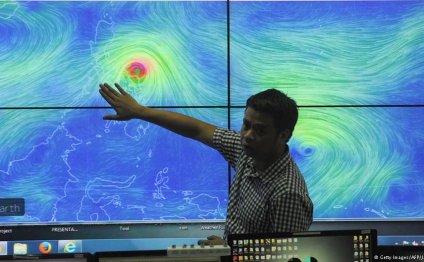
Typhoon season in Philippines
Overview of Philippines Weather
Most important! - Be aware of any typhoons affecting the Philippines by looking daily at the typhoon warning satellite image below. The image is live from the US Navy website.
The Philippines is in the tropics and therefore does not experience 4 seasons - Filipinos generally have no concept of spring or autumn
Near sea level, the temperature is somewhere between warm and very hot, 365 days a year, day and night - note though that some buildings and public transport can have airconditioners set to very cold.
It is very hot when the sun is out, and less so when it is overcast.
It is always humid, but reduces with altitude. e.g. your skin can get quite dry in Sagada.
It can get quite cold at night in the mountains - under 10 degrees in January - so pack a light jacket.
December, January and February are the coolest months.
March, April and May are the hottest months.
The typhoon season is June to November, but occasionally typhoons occur outside of the typhoon season.
Monsoonal rains and thunderstorms can occur randomly during the typhoon season and are usually very localized and therefore are not very predictable. Look at a satellite weather image and check on the amount of cloud cover or water vapor over your area.
Even if a typhoon is not going to hit directly, it can bring rain to areas a thousand-plus KM away.
Typhoons and heavy rain frequently cause landslides, causing roads to be cut. Local busses and jeepneys operate between landslides to ferry people around, but it can be a big problem if you have a private car. If you want to travel in the mountains during the wet season, it is best to do so at the beginning of your holidays - delays will then not cause you to miss your flight out of the Philippines.
Typhoons, heavy downpours, and long continuous rain can cause severe flooding in Manila. Because much of Manila is at sea level, or below, flood waters can stay for a very long time. Only when the ocean tides are low will the water drain away.
Typhoon Awareness
It is important to be typhoon aware when travelling in the Philippines. "Typhoon" is the local name for a tropical cyclone. You need to know if a typhoon is coming, and, if so, where is it going and what is its severity. Don't just rely on local news or the advice of local people.
Below is an up-to-date image from the US Naval Maritime Forecast Center / Joint Typhoon Warning Center (NMFC/JTWC). It which will give you the earliest warning of a typhoon. You can see it from this page or go directly to the Navy website and see it from there.
"Poor" tag means that the weather at a point they are tracking looks ominous but has a poor chance of developing into a typhoon.
"Fair" means there is a fair chance of it developing into a typhoon.
"TD" means tropical depression.
"TS" means tropical storm.
"TY" means Typhoon.
Once a weather system develops into a tropical depression or beyond, you can get get predictions about its path and intensity by following this link Weather Links. WIth this tropical cyclone information, you can now better plan your holidays.
Note that even a tropical depression can bring a tremendous amount of rain resulting in massive flooding or landslides.
Early Tropical Cyclone Warning - US Naval Maritime Forecast Center / Joint Typhoon Warning Center

The US Navy and Japanese weather website gives valuable typhoon information and forecasts. There are others also, so familiarize yourself with one before you commence your Philippines holiday, especially if you intend to travel during the typhoon season. These sites will usually give several to many days notice of a typhoon and its path so you can plan around it. This is what I do ...Always!
The Philippines weather service provided by PAGASA is useful for checking day to day weather conditions around the Philippines but it is not particularly good for advanced information.
Due to the sinking of a large passenger ferry in 2008, there are now tighter restrictions on passenger ships leaving in bad weather conditions. Expect that you will not be able to travel by sea several days before a typhoon hits and a day or so after it leaves.
RELATED VIDEO



Share this Post
Related posts
Famous beaches in Philippines
But of course… I understand that this can be a big ‘leap’, so if you are not ready or if you don’t have enough resources…
Read MoreBest Resort in Philippines on Beach
Most Luxurious Resorts in the Philippines | TripsToDiscover.com
Read More










